 Leading Ladies, a dance musical that was conceived, written, and filmed in Champaign, is making its C-U debut this weekend at The Art Theater. In June 2009, when the film crew was on location here, I was preparing for, attending, and recovering from an ALA library conference, and I wasn’t even aware that a movie was being filmed in Champaign. My first clue that something incredible had taken place here was when I splogged David Ward’s Variety press release back in June 2010. My priorities? Out of whack.
Leading Ladies, a dance musical that was conceived, written, and filmed in Champaign, is making its C-U debut this weekend at The Art Theater. In June 2009, when the film crew was on location here, I was preparing for, attending, and recovering from an ALA library conference, and I wasn’t even aware that a movie was being filmed in Champaign. My first clue that something incredible had taken place here was when I splogged David Ward’s Variety press release back in June 2010. My priorities? Out of whack.
Fortunately, Dan Schreiber wrote a damn fine article about the movie for Smile Politely while the crew was filming here. Dan is an actual writer for this magazine (unlike yours truly) and it shows, so if you want background about the film (and why wouldn’t you?) be sure and check it out.
I was fortunate to meet David Ward at the Leading Ladies booth at CU Pride Fest, and while he was pasting a lovely Let Love Lead tattoo on my arm, I asked him for an interview for Smile Politely, and he acquiesced. I had no idea if he was being polite or not, but I chased him down anyway. Not only did the amazing Mr. David Ward stand by his word, but he also put me in touch with Tea(h)m Beahm (Daniel: co-director, producer, music supervisor, etc.; Erika: co-writer, co-director, choreographer, etc.) and Jennifer Bechtel (co-writer, etc.).
Dear SP.com readers, the following is a composite of three different interviews conducted in two different mediums (email and in-person) that are cut, pasted, and edited into — hopefully — one, long, interesting, flowing, coherent conversation.
~~*~~
SP: Erika and Daniel wore several hats in this film, apart from their official duties. David and Jennifer, what about you?
Jennifer Bechtel: I co-wrote the screenplay and I helped with some of the initial casting process and helped to write one of the songs that’s featured. They did a version of it for the movie.
David Ward: Originally, I was the location manager, meaning ‘the scout,’ if you will. Erika, Jennifer, and Dan had some ideas for locations. Jennifer had some contacts, and she’d put out feelers to people possibly interested in letting us use their space. She and Erika gave me ideas of what they were looking for and I took them, scouted out places, and formalized arrangements.
That was my main role during filming, but on top of that came everything else. We had a crew of sixty, which seems like a lot, but there wasn’t anyone…basically, the first day on the movie set I was cleaning the toilets. Another of my jobs was to make sure that the garbage had somewhere to go. As location manager, I was the first person on the set and the last person off. During the day, while everyone was filming, I’d be off checking the next location we’d be filming. I didn’t realize it at the time, but the location manager in a ‘real’ movie does far less than I actually did. So by the end of the film, because I performed a lot more tasks than a location manager usually does, they generously upped me to co-producer, and eventually executive producer because I raised some money also.
I was also the set medic, because I’m a paramedic. But nothing happened more than scrapes. We used a lot of ice packs.
SP: Why did you choose Champaign for your location?
Erika Beahm: Having met my dear friend and writing collaborator, Jennifer Bechtel, in downtown Champaign and writing the film with a ‘Midwestern heart,’ we always knew we wanted to shoot in Champaign-Urbana. Daniel and I are mid-westerners, and we believe in the generosity of the Midwestern communities we grew up in. We also wanted to tell a story that was just about a ‘regular old family,’ one that folks could self-identify with and come to greater understanding about the film’s themes because the story took place in their own backyard.
David [to Jennifer]: Tell the back story behind your meeting with Erika.
Jennifer: I owned a toy and novelty gift store in downtown Champaign called Hot Diggity that lasted for about a year and a half. We sold really, really cool stuff that nobody needed at a time when, unbeknownst to us, the economy was going to start tanking.
David [laughing]: It was an awesome store.
Jennifer: And some would come in and treat it as the coolest museum ever, but not buy anything, but it was cool, and on my birthday, while we owned the store, I was giving 10% discounts to people as my birthday present to my customers, my ‘friends,’ who were pretty much anyone who came into the store, and I said something about that to someone and Erika was standing nearby. I’d never met her before and she turned around and said, ‘I’ll be your friend,’ and so we start talking, and within an hour of knowing each other we start talking about how we needed to write a movie together. I don’t know how that happened exactly, but within a month of that meeting we had the entire basic outline of the plot and the characters and had named everybody and had figured out how things would go, and we started meeting once a week. All we could do was meet once a week, but we stuck to that one time that was sacred.
SP: How long was it from meeting to movie-making?
Jennifer: I think it took about two years to write the whole thing. And then we had revisions and so on. I think four years from the first meeting to wrap, which is actually a crazy short amount of time for a movie. It sounds like a long time…
SP: And taking into account the fact that you’d just met…
Jennifer: Yeah, so our whole relationship kind of revolves around this family that we willed into existence. So they’re real to us.
SP: Erika, regarding the characters, you’ve said that you consider this film a ‘meta-narrative of your life.’ Can you elaborate? And is it the same for you, Jennifer?
Erika: Jen and I used parts and pieces of a lot of different people we knew to shape the identities and specifics of our characters, giving them realism and depth because of their honesty. Though my family was not a ballroom dancing one, I have been a dancer my whole life and was, alongside my sister/best friend, raised very closely by my single mom. We used the shape of the story of my life in my early 20s: a sister who gets pregnant, the other who falls in love with a woman, and a mother who is out of the loop on both, to shape the narrative arc of the Campari family.
Jennifer: The mother is a combination of many people that both of us have known. Anyone who’s ever been involved in theater has known the mother in one form or another. But both of the main female characters are a little bit of both of us, and then they’re their own people too. There are things that we can’t pinpoint as ‘I’ve had that experience.’ We both connect with the characters in very different ways.
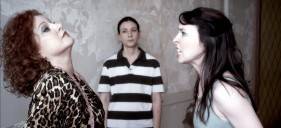 Erika: No one character is any one in our lives exactly; they all are composites of folks Jen and I know and our crafty imaginations. Both my mom and sister love the film, and laugh at the parts that speak most clearly to and about them. I can’t tell you how many times I heard, ‘No secrets from your mother!’ straight out of my mother’s mouth!
Erika: No one character is any one in our lives exactly; they all are composites of folks Jen and I know and our crafty imaginations. Both my mom and sister love the film, and laugh at the parts that speak most clearly to and about them. I can’t tell you how many times I heard, ‘No secrets from your mother!’ straight out of my mother’s mouth!
Jennifer: One or the other of us had experienced something in our lives that allowed us to connect with this or that character, and it really was this kind of seamless collaboration. We fell in love with the characters.
SP: Talk about your film locations in Champaign.
Jennifer: We needed a grocery store for the film, and Jerry’s IGA Round Barn is where I did half of my grocery shopping.
SP: Me too!
[brief pause to mourn the loss of the best grocery store in West Champaign]
Jennifer: They [IGA] were very open to our filming there. When I made the initial contact, I had no idea how involved the sequence was going to be, and how much we were actually asking of them. When I see what happens in that space in the scene — they built platforms for the dancing and moved everything around — they were extremely patient and supportive.
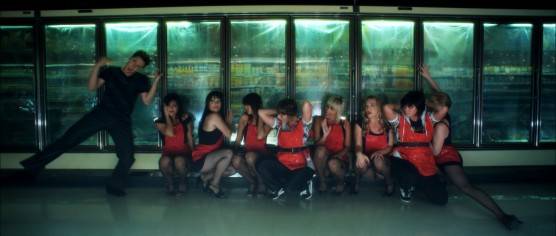
David: We were there Monday–Thursday, from 10:00 p.m.–6:00 a.m. We were allowed to start setting up while customers were still shopping. They were so incredibly supportive and it was like that with every location we were at.
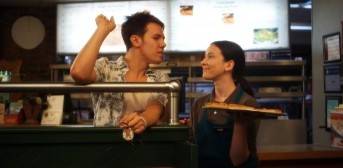 Jennifer: Village Inn was a similar experience. I knew Village Inn; I’d gone there since I was a kid. I went in there and thought, ‘This is a great spot,’ and I took Erika in and she immediately started dancing around this big fire pit in the middle of the room. And she went up to the counter and talked to the owner and it’s a classic Erika Moment. She’d decided what she wanted and she got it.
Jennifer: Village Inn was a similar experience. I knew Village Inn; I’d gone there since I was a kid. I went in there and thought, ‘This is a great spot,’ and I took Erika in and she immediately started dancing around this big fire pit in the middle of the room. And she went up to the counter and talked to the owner and it’s a classic Erika Moment. She’d decided what she wanted and she got it.
SP: Where was the gay swing club filmed?
David: That was in the old Rialto Theatre in Downtown Champaign. I’d heard of this theatre that used to exist, but when you look at the location, you think it can’t possibly be there. Boring brick building, right across the street from The Art.
I contacted the owners of the Rialto, which is Capel.com Photography, which is two gents, Bill and Ernie, partners who have been together forever. They use the main floor of the theatre as their photo studio, and have been rehabbing the theatre with their own money for fifteen years. In the end, we ended up using much of that building in the movie. Three key locations were all in the Rialto building. We where there for two weeks, and Bill and Ernie let us use their own office for our office space.
We filmed at Parkland College; we used the gym and some of the hallways at Franklin Middle School for the big Ballroom competition; we filmed the bathroom scene at the Armory on campus; we filmed in the alley behind the Virginia. The Krannert Center was very supportive with rehearsal space, set dressing, props, etc.
We needed the Compari family house, and we looked all over town, and it just so happened that some friends of ours…there was this empty house for sale, and it was within the vision that Erika had, and I contacted them, saying, ‘We’re making a movie and we want to take over your house.’ We were there much longer than expected, but the sellers were OK with it, and they literally gave us the key, and said, ‘Don’t break anything.’
We filmed everything in Champaign, except the very last scene, which was out at Allerton Park.
We got housing for an incredibly inexpensive cost at The McKinley Presbyterian Church and Foundation. We can’t possibly say enough how grateful we are to them. As we repeatedly added additional cast and crew, they’d say, ‘No problem,’ and that continued the entire time we filmed here.
This movie is an independent film, and we couldn’t have done it without the businesses and people and organizations in town. We asked, and they said, ‘Oh sure.’
Erika: Champaign was the epitome of generosity when we were shooting. In fact, I can’t imagine this film coming to life without the openness of the town that gave us so much.
SP: Leading Ladies is a low-budget, indie film. Erika, you’ve stated, ‘many current dance films suffer when they sacrifice acting for dancing or vice versa.’ Thanks to Dan’s initial article, we already know about your fantastic cast. How did you manage to sign such impressive talent?
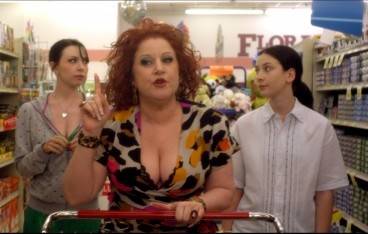 Erika: Casting an intimate story of five main characters takes perfect chemistry, a deep sense of family intimacy, and the ability to carry comedy and drama, all the while dancing up a storm! I knew Melanie LaPatin from So You Think You Can Dance (SYTYCD) and loved her choreography and splashy personality on screen — she’s like a bad ass ballroom diva Bette Midler. Jen, not familiar with the show, had already made contact with her in regards to a different actor who taught at her studio at the time. Once Jen told me who she was talking to, I started freaking out saying, ‘That’s Melanie LaPatin! We need HER!’
Erika: Casting an intimate story of five main characters takes perfect chemistry, a deep sense of family intimacy, and the ability to carry comedy and drama, all the while dancing up a storm! I knew Melanie LaPatin from So You Think You Can Dance (SYTYCD) and loved her choreography and splashy personality on screen — she’s like a bad ass ballroom diva Bette Midler. Jen, not familiar with the show, had already made contact with her in regards to a different actor who taught at her studio at the time. Once Jen told me who she was talking to, I started freaking out saying, ‘That’s Melanie LaPatin! We need HER!’
Jennifer: I had had phone conversations with Melanie, and I flew out to New York to meet with her, in part because Erika had decided this was going to happen, and I knew by that time that if she had decided that it was going to happen, it was going to happen, so I flew to New York and had lunch with this delightful woman who could be every bit a diva and she’s not.
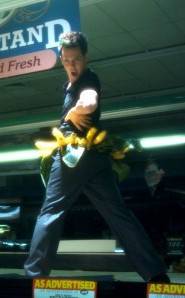 Erika: Once we had Melanie, she helped lead us to our other known television personality, Benji Schwimmer. A fan of his from his SYTYCD Season 2 win, I had always imagined him as our ‘Cedric.’
Erika: Once we had Melanie, she helped lead us to our other known television personality, Benji Schwimmer. A fan of his from his SYTYCD Season 2 win, I had always imagined him as our ‘Cedric.’
Jennifer: So Erika decided that she wanted Benji Schwimmer. I thought, ‘Well that’s great, but it’s not going to happen.’ Well, I should have known better. If Erika wants something to happen, it’s going to happen.
David [laughing]: I think Jen and I are gregarious and outgoing, but Erika is like that times ten. And Erika has this, ‘Let’s go do it!’ attitude that’s infectious.
Jennifer: And she fully believes that it’s possible, even though it shouldn’t be possible.
Erika: Adding those two stars and talents to our line-up really solidified the credibility of our mission to make a top-notch indie dance film. On our second trip to LA, in walked the incomparable Laurel Vail, who plays our lead, Toni, the sparkly wallflower who comes into bloom when she meets the magical Mona, played by Nicole Dionne. These two read together and the sparks flew and we knew we had found our love interests.
Shannon Lea Smith, who plays Tasi Campari, was my student at U of I. Shannon is a triple threat now performing in NY and touring, and is the fastest study on two feet. This was her first time in front of the camera and will not be her last.
David: I do want to stress that those of us who made this movie are new. We’d never done this before, but we had experienced professionals on board. We had big names within the film industry to coincide with us who were new to everything.
SP: Surrounding yourself with experts when you’re not one is smart.
Jennifer: I think it was Daniel who said that it was the best lesson in film-making that he could have ever possibly had to work with Pete Biagi. Just being next to him, watching what he was doing, getting his feedback. In the time that I saw their interaction, Pete was a consummate professional, but also this great teacher, guide, and mentor to everyone who was trying to learn. There were several people on the set who were anxious to learn and excited to be involved, but didn’t have the experience, and those people gained so much from this experience just being able to learn with people of his caliber.
David: Jason Pankoke was always very supportive of us too, and we really appreciated that. We’re constantly struggling against the local film perspective, though. We want and embrace the fact that we made it in Champaign, and there were a lot of locals involved. We love that, and couldn’t have made it to the quality that we did without filming it here. But at the same time, we’re more…when people hear ‘local film,’ I think they have a set idea of what a local film looks like. We’re not that. I don’t want to sound like an asshole, but…
Jennifer: I think that the biggest difference is the scale. We’re not comparing quality, but scale. Most movies that people are able to make in a smaller community with the resources that are available are limited to one location, or a couple of locations, with a really small cast, but the scale of this film is enormous. I mean, there are musical dance numbers. A billion different locations, and by all rights it should not be able to be made in this context.
SP: I think that everyone who is involved in the local scene here will know exactly what you’re talking about. Look at the music festival that’s playing this week. Look at the incredible world-renowned artists that Krannert Center brings here. Our readers will know what you’re talking about, and they won’t think you’re coming off as an asshole. You’re expressing your appreciation for what this city can achieve.
Jennifer: You look at a community this size, and you wonder what resources are available, but it helps that we’re located so close to so many major metropolitan areas. We had people coming in from St. Louis and Chicago and all over the place to help out and provide resources. These incredible people shouldn’t want to do this little movie out in the middle of a cornfield, but they did. And there’s a lot here as well.
David: We used top of the line digital film technology. We were able to do professional quality work on a very low budget. When people hear ‘local film,’ they often aren’t interested, but this is bigger and better than any movie that’s ever been made here. And we’ve played all over the country. The quality of the professionals that we’ve brought in is enormous. What I’m probably the most proud of is that that we sold out a 600-seat theater at the Directors Guild of America. I think people too, when they see the trailer, they’ll understand what we actually did here.

SP: Daniel, can you tell us about the musical score? Is the score new music? Old, familiar classics? Rock? Swing?
Daniel Beahm: When we started out making the film, I was going to score everything. I’ve been scoring film for nearly twenty years (yikes!), so I was excited to finally get to work on a project where I had complete creative control. As the time got closer and closer to start composing, I realized that there was NO WAY I would have enough time to score the project with all the other tasks on my plate (producing, editing, color, sound design, sound mix, etc.).
As I was editing, I just started dropping in music from friends that I’ve met while playing across the country, and I began realizing that this was the score — the passion and thoughtfulness that people put into their songs was exactly the kind of ‘score’ Leading Ladies needed. So on this project I shifted from composer to music supervisor.
All of the musicians that we knew personally were awesome, and I can’t wait to expose more of the world to their music. We also have a few ‘big label’ artists (Phoenix, Andrew Bird).
The big Grocery Store Musical number (“You Want a Piece of Me”) is a song written by John Painter, Ben Fold’s producer and a friend I met while working with Blue Yonder Films on the animated feature Hoodwinked. John wrote the song based on something Jennifer had composed with her friend Andrew Edwards, and then John recorded the song for Leading Ladies during production and sent it to us in Champaign so we could record Shannon’s incredible vocals (that’s really ‘Tasi’ singing!) at Mark Rubel’s Pogo Studio the week before we started shooting the scene.
John also hooked us up with another up-and-coming artist he is producing named Alva Leigh. Her song “Skyline” closes the film. This was so clearly the song for the final credits, that Erika would listen to it during production five or six times a night (seriously) before we’d finally fall to sleep for a couple hours before starting the day again. It was her way of visualizing the ‘end’ and is what she says kept her going during those days of little-to-no sleep.
I ended up writing about seven songs for the soundtrack. Most of them are just little snippets like what’s playing over the loudspeaker in the grocery store or hospital waiting room, but there is one ‘radio-ready’ song called “By the Bye” that gets used in the film as the song that plays during Benji and Jordan’s incredible West Coast Swing duet at The Top. For weeks I’d been sending Benji songs from friends and indie artists that I hoped would work for the number. Always he’d come back with ‘too slow,’ ‘too fast,’ ‘not enough flow,’ ‘wrong flavor,’ etc. I was about to give up when I found a demo on my computer for a song I’d written three years earlier while living in Champaign. Benji said it would work, and we had a song for the scene.
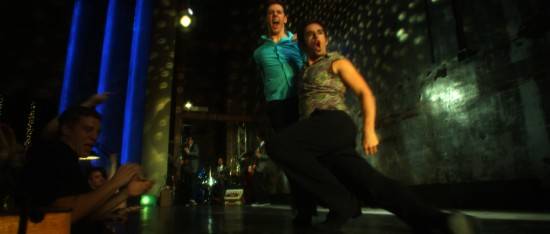
Ultimately, the sound track is a pretty eclectic mix. There is a lot of 50s and 60s influence that comes from the imagery you see on old latin/lounge album covers (which fits in perfectly with the ballroom dance themes). We’ve got some fantastic music written for the film by Austin artist Havilah Rand, including the opening number and the love theme. A lot of the rockabilly/swing music comes from a Columbus, OH band called The Randys. We’ve got Tangos from Germany and Uruguay. There are more than twenty cues in total.
I’m currently working on the artwork for the soundtrack cover and mastering the final songs, so hopefully we’ll have something ready before Christmas. For an indie film to have a soundtrack with so many artists is pretty incredible. Because of all the licensing, many indie films don’t even bother trying to get an actual physical soundtrack together, but since we have great relationships with almost every artist used in the movie, we are fortunate enough to have a final product.
SP: I’ve not seen the film, obviously, but I’ve watched the trailer and read the synopsis. And what struck me the hardest, was this otherwise benign sentence:
Cedric convinces Toni to go with him to his favorite gay and lesbian swing dance club (paraphrased).
What bothers me is not just that the only place Cedric and Toni can dance with partners of their own sex is a segregated bar, but also that the only competitive dancing they can perform is with partners of a different sex. We’ve all heard of queer square dancing, and the Gay Games allow same-sex dance competitions, but what about formal, national competitions? Do you think there will ever be a time when ballroom dance competitions welcome and accept same-sex dance partners?
Erika: I love that you see that the ‘otherness’ of same-sex pairing is relegated to an ‘underground swing club,’ playfully named “The Top” by myself and Jen. This is akin to the famous ‘I carried a watermelon’ scene in Dirty Dancing when all of the ‘low-brow’ dancing happens in the basement, away from the civility of the main stage. This segregation of otherness is, sadly, a huge part of our culture and dance is not exempt. Leading Ladies, though playful and family-friendly, and not dogmatic, uses dance as a way to look at the need for more equality everywhere. We do it without a specifically propagandized political agenda, but with the message to all to Let Love Lead — trusting our hearts to see what is right.
Presently, I only know of ‘segregated’ same sex competitions, and I wonder when and if that cross-over will occur. Will dance be a leader in cultural revolutions of equality or will it follow as things change in legislation and community?
Jennifer: There is some same sex partnering in some college level mainstream ballroom competitions, including the competitions in the Big 10, but I don’t think this happens on a grand scale.
Erika: There are little hidden details that voice our love of Love and equality — the number on Toni’s back at the competition is an 11, turned on its side, an equal sign. You will enjoy the speech Sheri makes before the judges on her daughter’s behalf, the talk of the ‘by-laws,’ and the moment we all hope to come to when we are faced with what is really important: love and family. ‘Dance for World Peace’ is something I have always half-teasingly said to my university students — I believe it just might actually be the way.
SP: Erika, you choreographed this film. Can you talk about gender roles and dancing? It seems to me that people get so focused on the sex of the dancers, that they forget that couple-dancing is about Leader and Follower, rather than Male and Female.
Erika: Collaborating with ballroom goddess, Melanie LaPatin, was an incredible learning experience — the collaborative spirit of this film is inherent in every aspect of our work. For me, the important thing about this being a dance film is my belief in the power of dance to literally move people into new places of understanding.
As a director, I used dance as the glue that bound this family together, but it could be fishing or religion or a family business. By using dancing as the unifying device, we could express things about same-sex partnership without having to be overtly political or dogmatic. Dance and the language of dance could do it for us.
After re-presenting recognizable elements already charged with content, we re-contextualize these images. Manipulating the famous heterosexual dance sequence from Dirty Dancing, by having it danced by two women, re-routed previously fixed notions of cultural definitions within popular culture. The original scene defined the blossoming sexuality of the women of my generation in sweet and powerful ways. A re-presentation of these charged images reignites adolescent hormonal memories today.
With Leading Ladies, the same-sex choreography pushes that button of awakening again, this time leaving open a wider representation of possible partnership by making room for same-sex pairings. Here, we reject the hetero-normativity and the marital-thrust of the usual movie musical, while still maintaining many of the generic conventions of the dance musical, leading the audience to cheer for the ‘Typical Hollywood Ending,’ though the protagonists are two women.
David: It’s a delicate balance. We’re very, very proud of this film. Erika and Jennifer wrote an amazing script, one that hasn’t been done before, particularly in mainstream film. And that’s the key. We made this film not for preaching to the choir. We know that gays and lesbians will love the movie and we embrace that and love that. But we don’t want to be known just as a gay and lesbian movie because the message that Jennifer and Erika put together in this movie also speaks to a mainstream audience.
Jennifer: The film is very much about Toni learning how to love, period. And specifically how to love herself and how to love her family, but not let her family dominate her view of herself and her life. That’s something that makes this film universal.
It’s not political. And there’s nothing wrong with political movies, but that’s not what this film is about. It’s a movie about love.
SP: With dancing.
Jennifer [laughing]: It’s a movie about love and dancing.
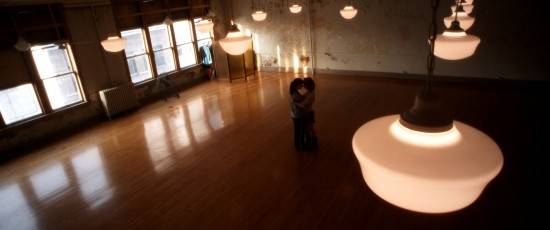
Leading Ladies is playing this Saturday and Sunday at The Art Theatre.
Saturday, Sept. 25, 7:30 p.m.
Sunday, Sept. 26, 2:30, 5:00, and 7:30 p.m.
You can reserve Saturday seats at The King Head Film Festival website.
All profits from the sale of tickets for [the Saturday] showing will be donated to The McKinley Foundation (Presby Hall) in recognition of their EXTREME generosity housing cast and crew during production of the film.
Official Trailer:








